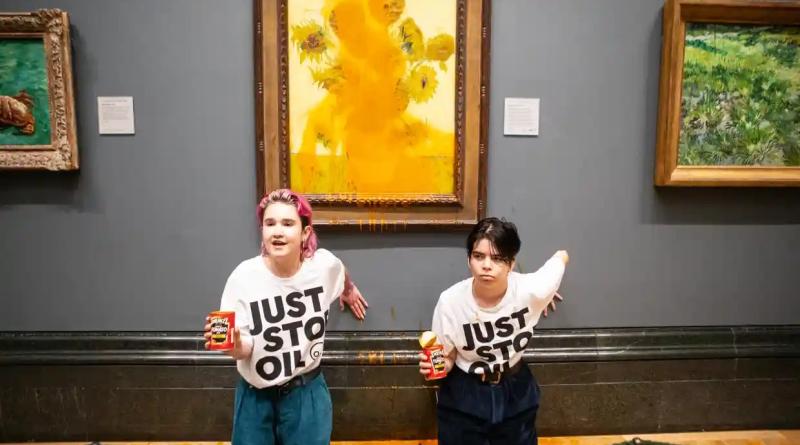I fund climate activism – and I applaud the Van Gogh protest

The Just Stop Oil protest shocked the world, but we must take disruptive action on the climate crisis before it’s too late
Two climate activists who threw soup on the protective glass covering of Van Gogh’s Sunflowers painting have captured the attention of the world. While some have ridiculed the activists, as a funder of climate activism, I am proud of the bigger conversation they have started.
When I saw the video, my first reaction was shock. Throwing soup on a beloved painting was a desperate move. What could possibly motivate a young person to do such a thing? This is where we find ourselves after decades of mostly incremental activism which has brought us to the point of a collapsing planet, engulfed in flame and drought, and burning to the ground. Activists are trying everything they can to get our attention. How far is too far to get the attention of people in immediate danger?
I am the daughter of a famous family who built their fortune on fossil fuels – but we now know that the extraction and use of fossil fuels is killing life on our planet. Our family sold that company four decades ago, and I instead vowed to use my resources to take every means to protect life on Earth.
People often come up with theories about my motivation to engage in the climate movement. My motivation is clear: I am fighting for a livable planet for my family and yours. I am not dwelling on the past. I am looking to build a better future.
I proudly provide funding to the Climate Emergency Fund, which in turn makes grants to climate activists engaged in nonviolent legal civil disobedience, including Just Stop Oil, the group the activists represented. I do not fund these groups directly, nor do I have direct control over which specific actions climate activists choose to take.
I believe the climate crisis has progressed to the point where we must take disruptive action to try to change course on a planet that is becoming increasingly unlivable. My support of climate activism is a values statement that disruptive activism is the fastest route to transformative change, and that we are out of time for anything other than rapid, comprehensive climate action.
The young activists rightly guessed that targeting a famous painting, familiar and personal to many of us, would strike a nerve. They have clearly stated that they never intended to do real damage to the art, knowing that it was covered in protective glass. The action was meant to disrupt the status quo, to call attention to the dire state of the planet and to demand the end of all new oil and gas exploration. It has caught our attention and kickstarted a conversation about what really matters.
We need to navigate through the mess to get to the real conversation: we need an energy transition as quickly as possible. Governments and corporations must stop expansion of fossil fuel infrastructure and scale up clean energy. We can have a fossil fuel-powered economy, or we can have thriving life on planet earth. We can’t have both. The unfortunate truth is that our planet has no protective glass covering.
Yet some have chosen to criticize the young activists. That criticism only makes it clearer how a person could take such a desperate step to get the world’s attention. Generations before them have destroyed a livable climate and now are telling them that how they are trying to save it is wrong. Older generations are judging and blaming them and yet have stolen their futures. Instead of criticizing young activists for trying to wake us up to the reality of our planet’s climate crisis, we should ask ourselves how to be better partners to those who are inheriting our wreckage. Climate anxiety, especially among our youth, is high and escalating. How will this anxiety manifest in our public and private spaces as the planet becomes increasingly unlivable?
My hope is that we, as a society, can wake up to accept these actions from brave climate activists for what they are – an alarm that jolts us out of the status quo and focuses us on the real emergency at hand: we are killing life on this planet. Nonviolent, civil resistance works. Many of the rights we hold dear were won by previous generations of young people standing up and saying enough. Should we not use those same tactics to redirect our anger and energy toward preserving life – our own and those around us?
As the planet burns, we are approaching a time when all we’ll have left are pictures and paintings of our beloved Earth, and urban art galleries may be the final resting place for Earth’s sunflowers.
coverphoto: The Van Gogh protest has caught our attention and kickstarted a conversation about what really matters.’ Photograph: Antonio Olmos/The Guardian




